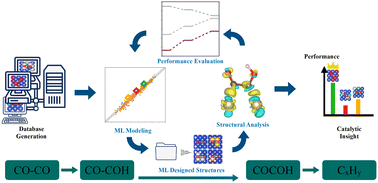Machine learning assisted binary alloy catalyst design for the electroreduction of CO2 to C2 products†
Abstract
The carbon dioxide reduction reaction (CO2RR) has become one of the most important catalytic reactions due to its potential impact on global emissions. Among the many products this reaction yields, C2 products are the most valuable due to their potential use as hydrocarbon fuels. For the efficient conversion of CO2 into C2 products, however, further work needs to be done on understanding the reaction pathway mechanisms and ideal catalytic surfaces. Herein, we gain insight into the C2 pathway through a combination of Density Functional Theory (DFT) and machine learning (ML) by studying the adsorption of *COCOH on eight different types of Cu-based binary alloy catalysts (BAC) and subsequently discover the ideal BAC surfaces through configurational space exploration. 8 different ML models were evaluated with descriptors for elemental period, group, electronegativity, and the number of unpaired d orbital electrons. The top performing models could successfully predict the adsorption energy of *COCOH on Cu-based BACs to within 0.095 eV mean absolute error (MAE). The most accurate models found Cu/Ag and Cu/Au BACs with 2–3 atom nanoislands on the surface and high Ag/Au density subsurfaces had the most favorable reaction energy pathway which corresponds with the weakest *COCOH adsorption energies.

- This article is part of the themed collections: Carbon capture, storage or utilisation – Topic Highlight, Machine Learning and Artificial Intelligence: A cross-journal collection and Artificial Intelligence & Machine Learning in Energy Storage & Conversion


 Please wait while we load your content...
Please wait while we load your content...